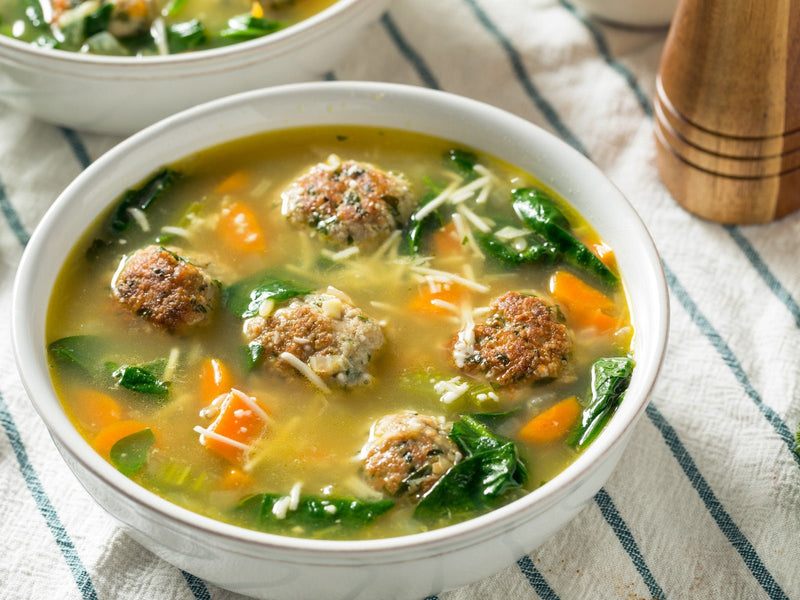
Soup, with its warm, nourishing qualities, offers a comforting embrace that soothes the soul.
It's the perfect remedy for chilly days, providing both sustenance and solace. The aromatic steam, rich flavors, and wholesome ingredients combine to create a culinary experience that evokes feelings of care and contentment. In every culture, soup is a symbol of hospitality and love, making it a timeless comfort food that brings people together. When we're sick, we often think of soup as a remedy for the flu, the common cold and occasionally a broken heart.
A History as Rich as the Broth:
Soup's history stretches back an incredible 20,000 years, predating most written records. The word "soup" itself comes from the Latin "suppa," meaning "bread soaked in broth." While its origins are lost to time, soup variations exist in every culture around the world.
Beyond Chicken Noodle:
There's a whole world beyond the comforting classic, chicken noodle soup. From clear broths (bouillon, consommé) to thick and hearty stews, the possibilities are endless.
Endless Variations:
The beauty of soup lies in its versatility. Explore a world of flavors with options like:
- Veggie Delights: Pumpkin, carrot, potato, cauliflower, broccoli, cabbage - the list goes on!
- Seafood Sensations: Shellfish, fish, and all the treasures of the ocean.
- Meat Marvels: From classic stews to lighter options, meat adds depth and satisfaction.
The variations on a pot of soup are endless and quite honestly there's no right or wrong way to make a soup and that's the best thing about it.
What is the healthiest soup to eat?
- The healthiest soup to eat depends on individual dietary preferences and nutritional needs. Generally, soups made with fresh vegetables, lean proteins, and low-sodium broth tend to be nutritious choices. Opt for broth-based soups over creamy ones to keep calorie and fat content lower. Additionally, soups packed with fiber-rich ingredients like beans and whole grains offer sustained energy and promote digestive health.
What is the difference between broth and consommé?
- While both broth and consommé are clear soups, they differ in their preparation and flavor intensity. Broth is typically made by simmering meat, vegetables, and aromatics in water, resulting in a flavorful liquid base. Consommé, on the other hand, undergoes a more intricate clarification process where egg whites are used to remove impurities, resulting in a crystal-clear broth with a richer, more concentrated flavor profile.
What cultures have unique soup traditions?
- Many cultures around the world boast unique and diverse soup traditions. For example, in Italy, minestrone is a hearty vegetable soup featuring seasonal ingredients and often includes pasta or beans. In Japan, miso soup is a staple, made from fermented soybean paste mixed with dashi broth and various additions like tofu, seaweed, and green onions. Meanwhile, in Thailand, Tom Yum soup tantalizes taste buds with its spicy and sour flavor profile, featuring ingredients like lemongrass, chili peppers, and shrimp.
What are some soup ideas for a vegan or vegetarian?
Vegan and vegetarian soups offer a plethora of delicious and nutritious options for plant-based eaters. These vegan and vegetarian soup ideas showcase the abundance of flavors and ingredients available in plant-based cooking.
- Lentil Soup: Packed with protein and fiber, lentil soup is hearty and satisfying. Combine lentils with vegetables like carrots, celery, and tomatoes for a nutritious and flavorful meal.
- Vegetable Minestrone: A classic Italian soup, minestrone is a versatile dish that can be customized with an array of vegetables, beans, and pasta. Simply simmer vegetables in a tomato-based broth seasoned with herbs like basil and oregano for a comforting bowl of goodness.
- Coconut Curry Soup: This Thai-inspired soup features creamy coconut milk, flavorful curry paste, and an assortment of vegetables like bell peppers, broccoli, and spinach. Garnish with fresh herbs and lime for a burst of freshness.
- Roasted Butternut Squash Soup: Rich and velvety, roasted butternut squash soup is a fall favorite. Roast butternut squash until caramelized, then blend with vegetable broth, spices like cinnamon and nutmeg, and a touch of coconut milk for added creaminess.
- Black Bean Soup: Protein-packed black beans are the star of this hearty soup. Combine black beans with onions, garlic, tomatoes, and spices like cumin and chili powder for a Southwestern-inspired dish that's sure to satisfy.
How to make soup from leftovers?
Making soup from leftovers is a fantastic way to reduce food waste and create flavorful meals.
- Start by gathering any leftover proteins, vegetables, grains, or legumes you have on hand.
- Sauté aromatics like onions, garlic, and herbs in a pot until fragrant.
- Add your leftover ingredients along with broth or water and simmer until everything is heated through and flavors meld together.
Feel free to get creative with seasonings and spices to enhance the taste of your leftover soup creation.
Thicken It Up:
- Classic Starches: Achieve a creamy texture with potatoes, flour, or rice.
- Creamy Indulgence: Add richness with ingredients like cream, egg yolks, Greek yogurt, or butter.
- Healthy Options:Lentils or grains like barley, farro, buckwheat or millet add a hearty, nutritious dimension.
What are the best soups for winter?
Winter calls for hearty and comforting soups that warm the soul and nourish the body. Here are some of the best soups to enjoy during the chilly winter months:
- Chicken Noodle Soup: A classic favorite, chicken noodle soup is both comforting and nourishing. Tender chicken, aromatic vegetables, and hearty noodles simmered in a flavorful broth create a bowl of warmth and nostalgia.
- Beef Stew: Rich and savory, beef stew is the epitome of winter comfort food. Slow-cooked beef, root vegetables like carrots and potatoes, and aromatic herbs come together in a thick and hearty stew that's perfect for cold winter evenings.
- Minestrone: This Italian soup is made with vegetables, pasta, and beans. It's a hearty and flavorful soup that's perfect for a cold winter day.
- Tomato Basil Soup: Tangy tomatoes and fragrant basil combine to create a vibrant and comforting soup that's perfect for dipping crusty bread. Whether enjoyed on its own or paired with a grilled cheese sandwich, tomato basil soup is a winter classic.
- French Onion Soup: This French classic is made with caramelized onions, beef broth, and croutons. It's a hearty and flavorful soup that's perfect for a cold winter night.
- Split Pea Soup: Made with hearty split peas, flavorful ham or smoked turkey, and aromatic vegetables like onions and carrots, split pea soup is a satisfying and nutritious option for chilly winter days. Serve with a slice of crusty bread for a complete meal.
- Butternut Squash Soup: Creamy and velvety, butternut squash soup is a winter favorite that's both comforting and nutritious. Roasted butternut squash, aromatic spices like cinnamon and nutmeg, and a touch of cream create a luxurious soup that's perfect for warming up on cold winter nights.
These winter soups are sure to chase away the chill and bring comfort and warmth to your table during the coldest months of the year.
What are the best soups for summer?
While summer is often associated with lighter fare, soups can still be a refreshing and satisfying option on hot days. Here are some of the best soups to enjoy during the summer season:
- Gazpacho: A cold Spanish soup made with ripe tomatoes, cucumbers, bell peppers, onions, and garlic, gazpacho is a refreshing and vibrant option for summer. Served chilled, gazpacho is perfect for cooling down on hot days.
- Chilled Cucumber Soup: Light and refreshing, chilled cucumber soup is a cooling option for summer. Made with crisp cucumbers, yogurt, dill, and lemon juice, this soup is both hydrating and flavorful.
- Watermelon Gazpacho: A twist on the classic gazpacho, watermelon gazpacho is a sweet and savory soup that's perfect for summer. Juicy watermelon, tomatoes, cucumbers, and herbs come together to create a refreshing and hydrating dish.
- Chilled Avocado Soup: Creamy and indulgent, chilled avocado soup is a luxurious option for summer. Blended avocados, cilantro, lime juice, and yogurt create a silky-smooth soup that's perfect for hot days.
- Cold Asian Noodle Soup: Light and flavorful, cold Asian noodle soup is a refreshing option for summer. Rice noodles, crisp vegetables, and fresh herbs are tossed in a tangy dressing made with soy sauce, rice vinegar, and sesame oil for a delicious and satisfying meal.
These summer soups are perfect for keeping cool and refreshed during the hottest months of the year, providing a burst of flavor and hydration when you need it most.
What spices can I add to soup for more flavor?
Adding spices to soup is a fantastic way to enhance its flavor profile and create a more dynamic culinary experience. Here are some spices you can add to soup for an extra burst of flavor:
- Cumin: Cumin adds a warm and earthy flavor to soups, making it perfect for dishes inspired by Mexican, Middle Eastern, or Indian cuisines. Try adding cumin to lentil soups, chili, or vegetable stews for a delicious twist.
- Paprika: Paprika adds a subtle smokiness and mild heat to soups, elevating their flavor without overwhelming the dish. Use sweet or smoked paprika in recipes like tomato soup, potato soup, or bean soups for a rich and complex taste.
- Turmeric: Turmeric offers a vibrant color and a slightly peppery flavor to soups, making it a popular choice in Asian and Middle Eastern cooking. Add turmeric to vegetable soups, lentil soups, or coconut-based soups for both flavor and visual appeal.
- Thyme: Thyme imparts a delicate and aromatic taste to soups, adding depth and complexity to the dish. Use fresh or dried thyme in recipes like chicken soup, potato soup, or mushroom soup for a subtle herbal flavor.
- Ginger: Ginger adds a zesty and slightly spicy kick to soups, making it perfect for Asian-inspired dishes. Try adding fresh grated ginger to noodle soups, coconut-based soups, or carrot soup for a burst of flavor and warmth.
- Coriander: Coriander has a citrusy and slightly sweet flavor that compliments a wide range of soups. Use ground coriander in recipes like tomato soup, lentil soup, or Moroccan-inspired soups for a unique and aromatic twist.
- Cayenne Pepper: Cayenne pepper adds fiery heat and a punch of flavor to soups, so use it sparingly if you're sensitive to spice. Add a pinch of cayenne pepper to chili, bean soups, or seafood soups for a subtle kick.
- Bay Leaves: Bay leaves add a subtle herbal flavor and aroma to soups, enhancing their overall depth and richness. Use dried bay leaves in recipes like beef stew, chicken soup, or lentil soup for a classic and comforting touch.
Experimenting with different spices is a great way to customize your soups to suit your taste preferences and create exciting new flavor combinations. Just remember to taste as you go and adjust the seasoning accordingly to achieve the perfect balance of flavors.
The comforts of a bowl of soup extend far beyond its warmth and nourishment. Soup has a unique ability to soothe the soul, evoke cherished memories, and bring people together around the table. Whether it's a steaming bowl of chicken noodle soup on a cold winter's day or a refreshing gazpacho on a sweltering summer afternoon, soup offers a taste of comfort and familiarity in every spoonful. As we embark on our culinary journeys and explore the diverse world of soups, let us savor each moment, knowing that a simple bowl of soup has the power to comfort, nourish, and delight us in ways that are truly timeless.
Let's Get Cooking
For more culinary inspiration, be sure to visit our recipe page. Here, you'll find a diverse collection of delicious recipes for every taste, season and occasion.

